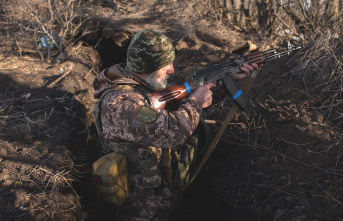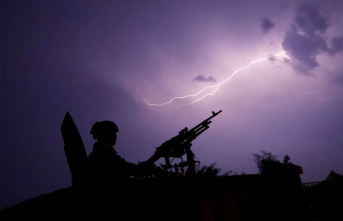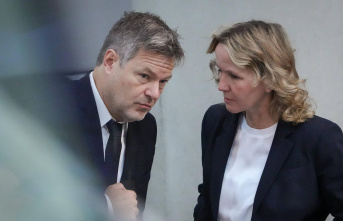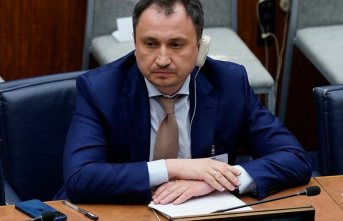Such numbers could cause unrest: for every inhabitant of the Schleswig-Holstein village of Seeth, which has almost 700 inhabitants, there is more than one refugee. Around 790 people refugees and asylum seekers are housed in the state accommodation for refugees (Luk) there, as of March 21. In addition, there are 17 refugees assigned to the municipality. Most of the people in the Luk (719) come from Ukraine. The remaining residents are asylum seekers.
The honorary mayor of Seeth, Ernst-Wilhelm Schulz, invites you to a conversation in his living room. He is incredibly proud of his citizens, he says over coffee and cake. Proud of the acceptance of the situation, even if the ratio between refugees and residents does not fit numerically. When asked about the refugees in the village on the street, a dog owner says that you hardly notice her. Sometimes some are present at events such as the lantern parade.
"They are citizens, like everyone else"
When the hatch was reopened about a year ago after the start of the Russian war of aggression against Ukraine, there was an incredibly great willingness to help, as Schulz describes. Sometimes the Seether are also invited to events in the state accommodation. "I go there every time. That goes without saying. They are citizens, just like everyone else."
Seeth is a village in rural North Friesland. It is about six kilometers from the small town of Friedrichstadt, and the bus ride to Husum takes around 40 minutes. There is a baker, a fire brigade, a sports club, a rifle club, ring riders, a theater group. No doctor, no school, no kindergarten. The nearest grocery store is in the village of Stapel, which is about three kilometers from the state shelter. Few people are out on the streets on this rainy day.
Protests in Mecklenburg-West Pomerania
The coexistence and coexistence of locals and refugees does not work so quietly everywhere. In Mecklenburg-Western Pomerania, for example, plans to build accommodation in the 500-inhabitant town of Upahl have been causing protests for weeks. Container accommodation with 400 spaces was initially planned here. Most recently, the district council decided to demand a limit of 200.
According to the State Office for Immigration and Refugees, the number of refugees and asylum seekers who come to Schleswig-Holstein alone has multiplied as a result of the war in Ukraine. In 2021 4209 people came, in 2022 there were 37,434. According to the Federal Ministry of the Interior, a good 1.055 million people (as of March 21, 2023) came to Germany in connection with the Ukraine war alone.
After the beginning of the war, state accommodation was reactivated in the northernmost federal state. One of them is in the former Stapelholm barracks in Seeth. "We were under a lot of pressure at the time because a lot of people came to Schleswig-Holstein from the Ukraine," said Wolfgang Kossert, spokesman for the State Office for Immigration and Refugees. "We needed additional accommodation. The vacant barracks, which used to be state accommodation, were ideal for this." At first, only Ukrainians were housed here, but asylum seekers have been coming again for some time. So far, the hatch should be closed again at the end of 2023 - but there are indications that the contract will be extended until 2024.
Desperate search for housing
Originally, the people who arrived at the state shelters were supposed to be assigned to a commune after about ten days. But the cities and municipalities do not have enough living space for the many people - and in November the state government increased the length of stay in the state accommodation to several weeks.
Everywhere there is a desperate search for living space, municipalities and districts do not know how to accommodate people. Container villages arise out of necessity, but this can lead to problems like in Upahl. In addition to the financial question, this will probably be one of the most pressing issues at the planned federal and state refugee summit on May 10th.
In Seeth, too, the mood could change at some point, says the mayor. That also depends on the clientele - and the behavior of each individual. He has an open ear for all opinions of his citizens - for positive as well as negative. And there are definitely different opinions. "But I always appeal to understanding."
"We try to solve the problems"
One is in regular contact with the surrounding communities to talk about the burden, says Kossert. "We try to solve the problems." The environment is very cooperative. In addition, the accommodation is very large compared to the communities around it, says Kossert. But based on experience in other state shelters, structures have been set up that bind people to the shelter. "They are busy here during the day."
There is a school on the site, a kind of kindergarten, medical care, a women's café, leisure activities for adults, young people and children, as the head of the facility, Sönke Jensen, lists. You can rent bikes, play table football or table tennis. Handicraft courses for children or sewing courses are offered. There is also WiFi almost everywhere.
"It's very different from a place where nothing is offered," says Kossert. "In which people are only accommodated and then swarm out into the surrounding area if necessary." And basically he has the feeling "that here in Schleswig-Holstein we have the whole issue of immigration management under control and thus also contribute to a good coexistence in Schleswig-Holstein and society".











